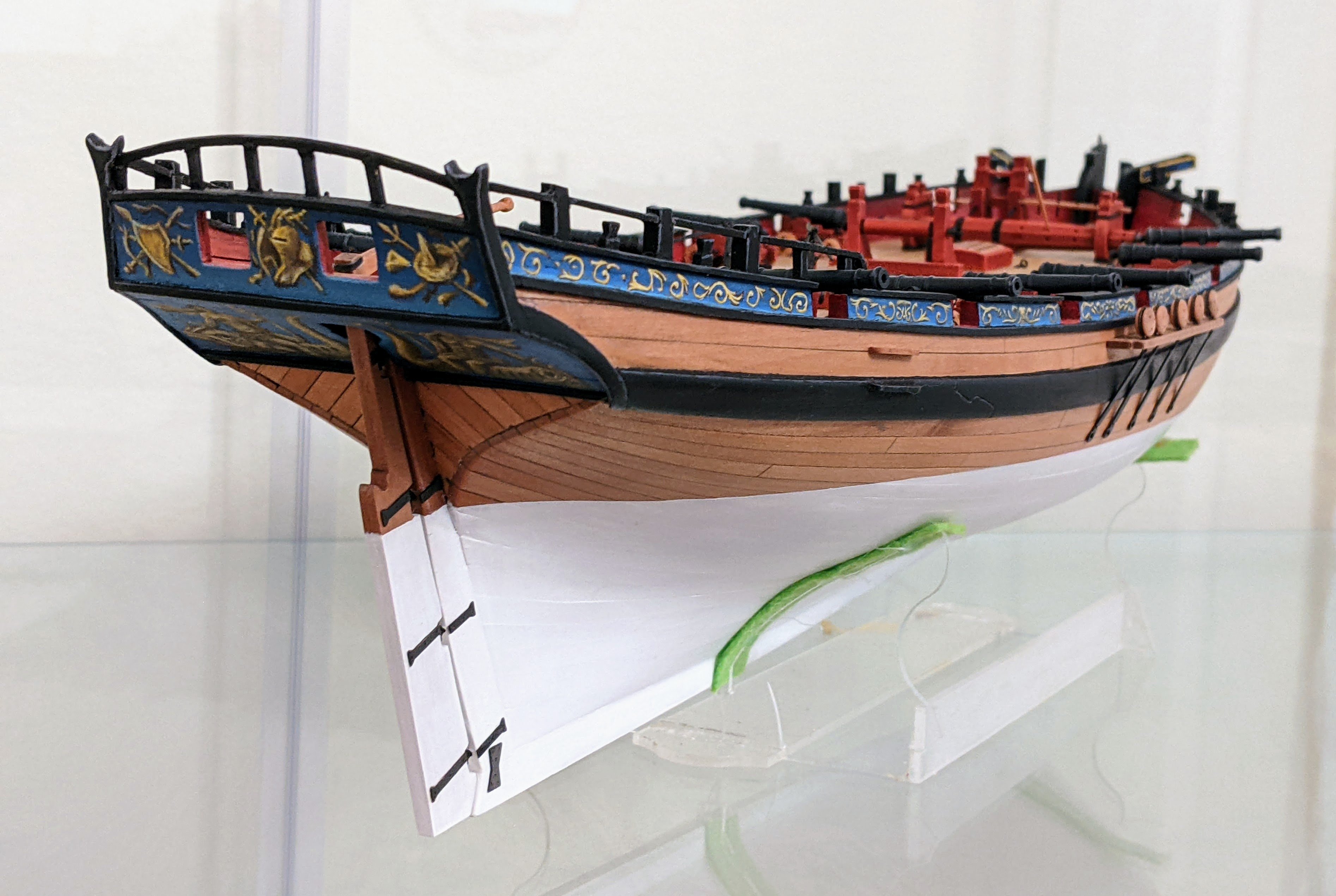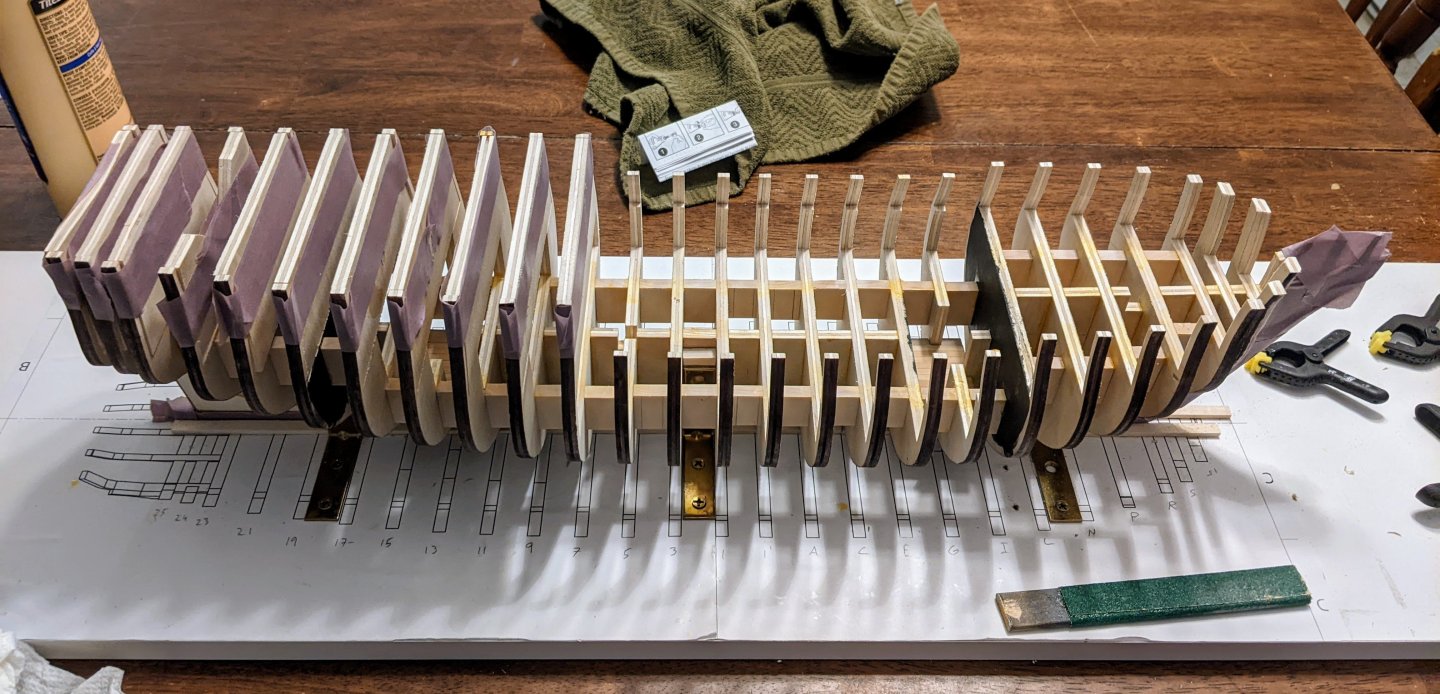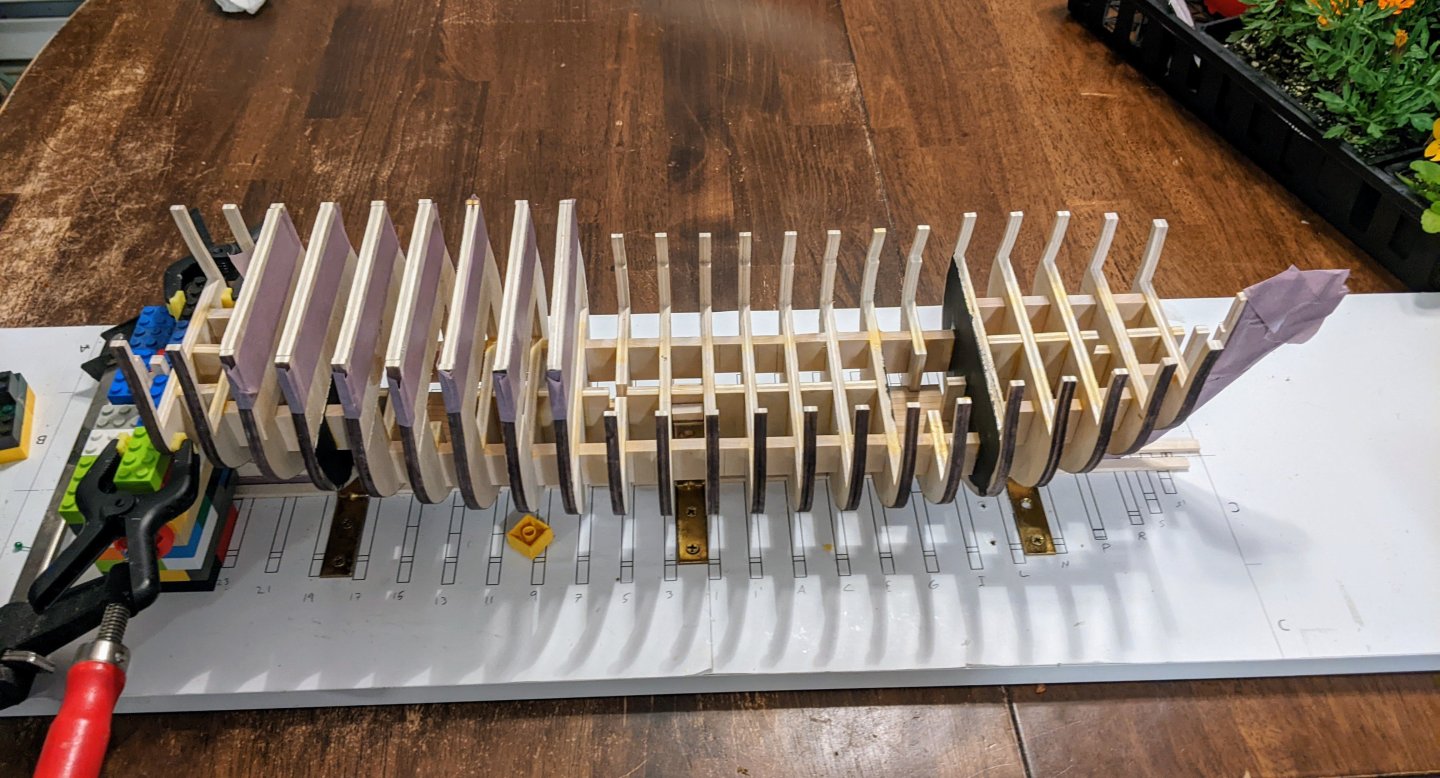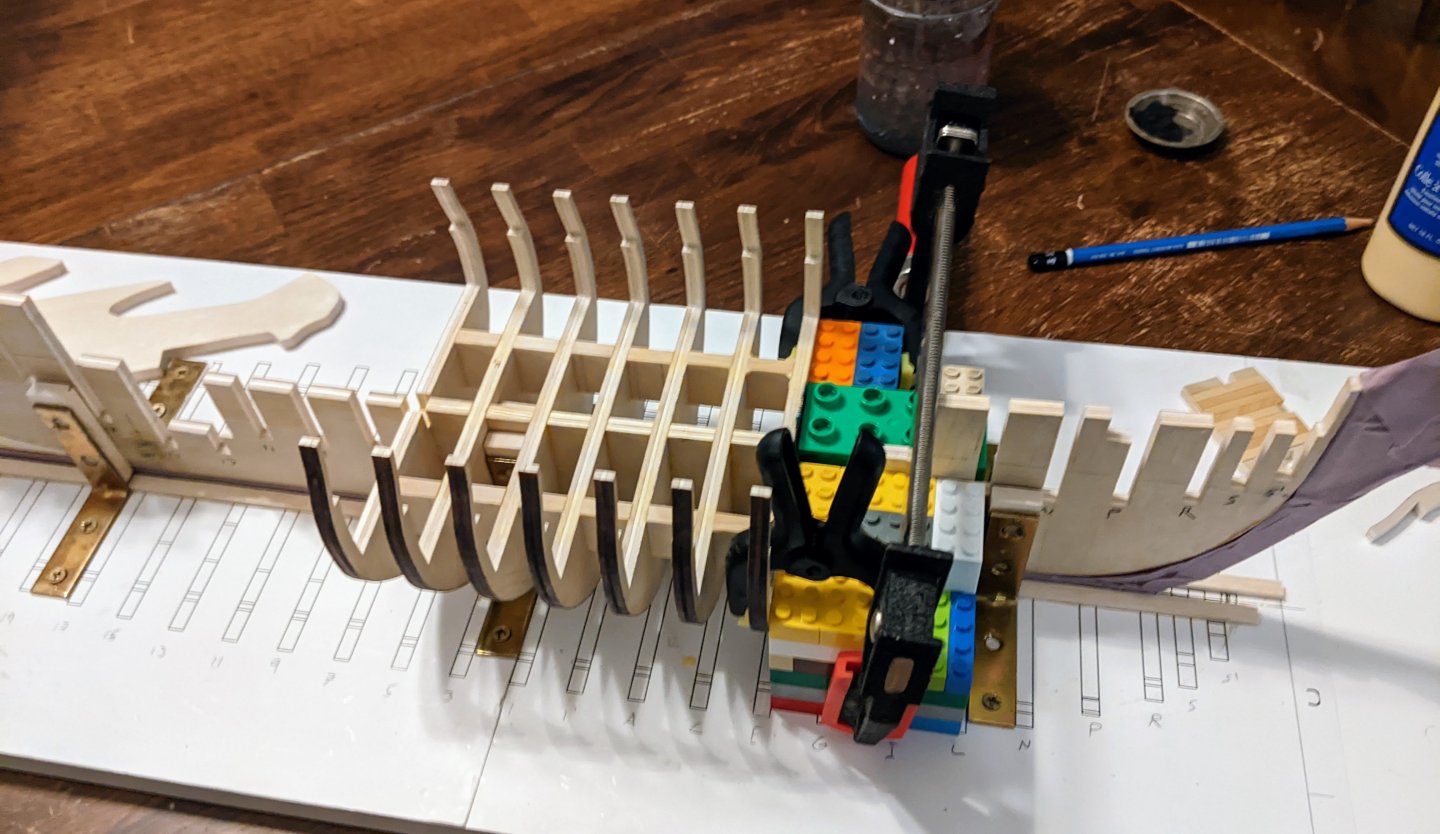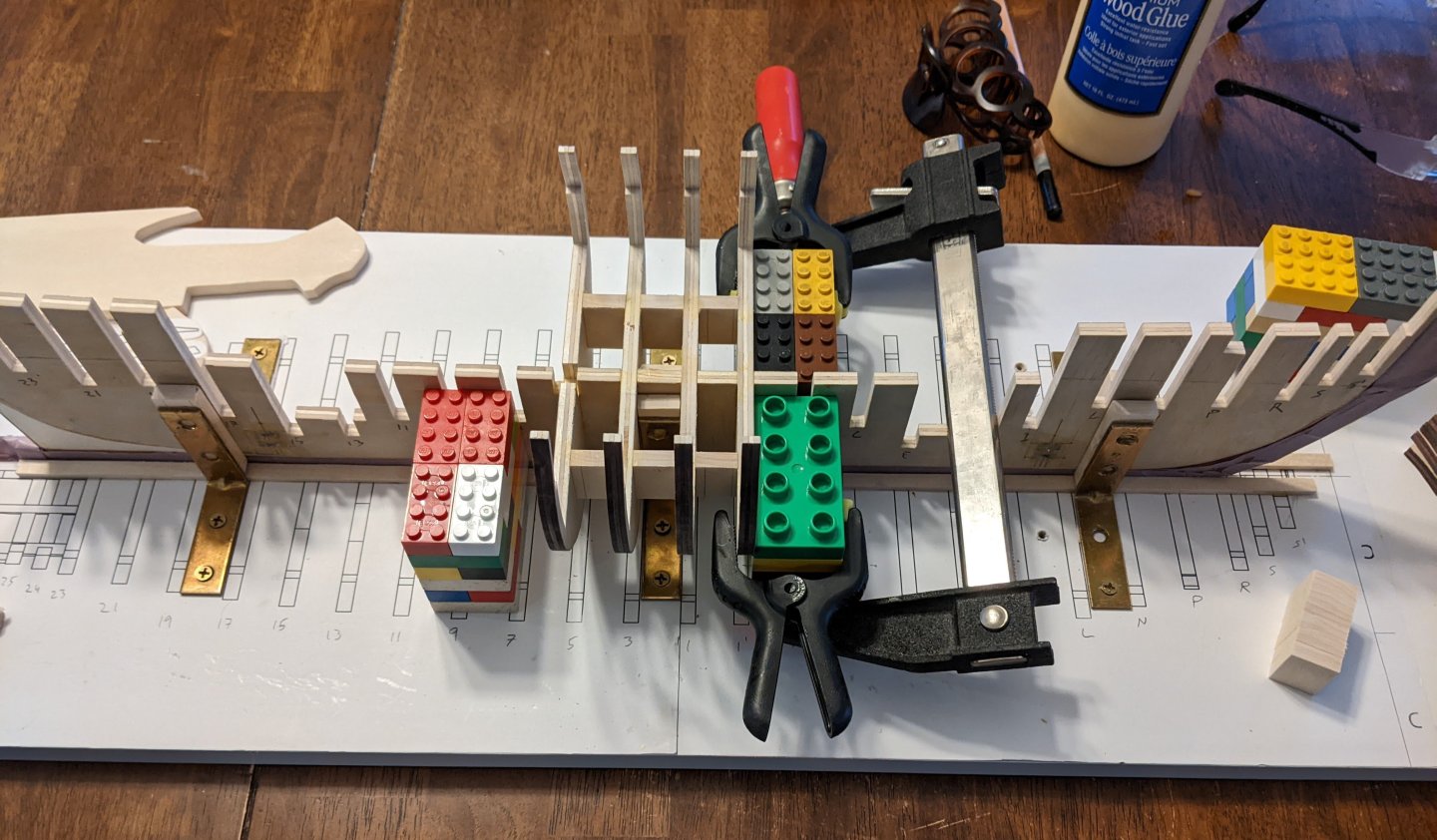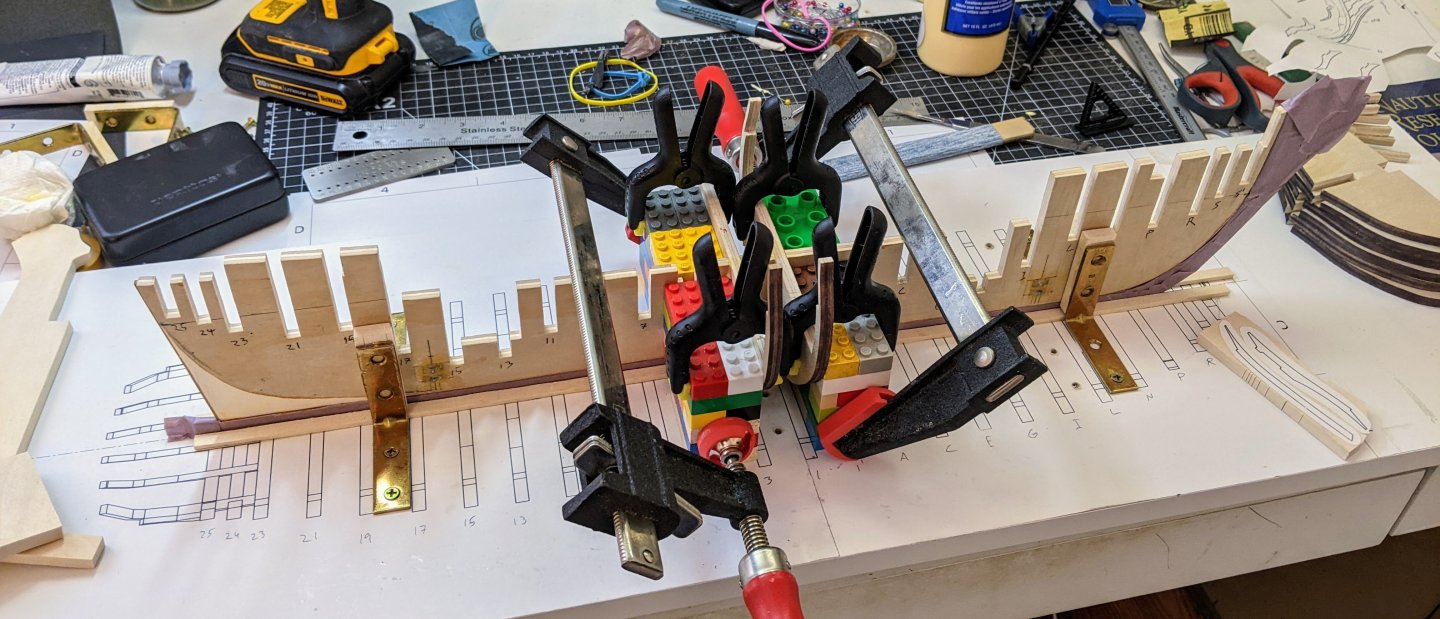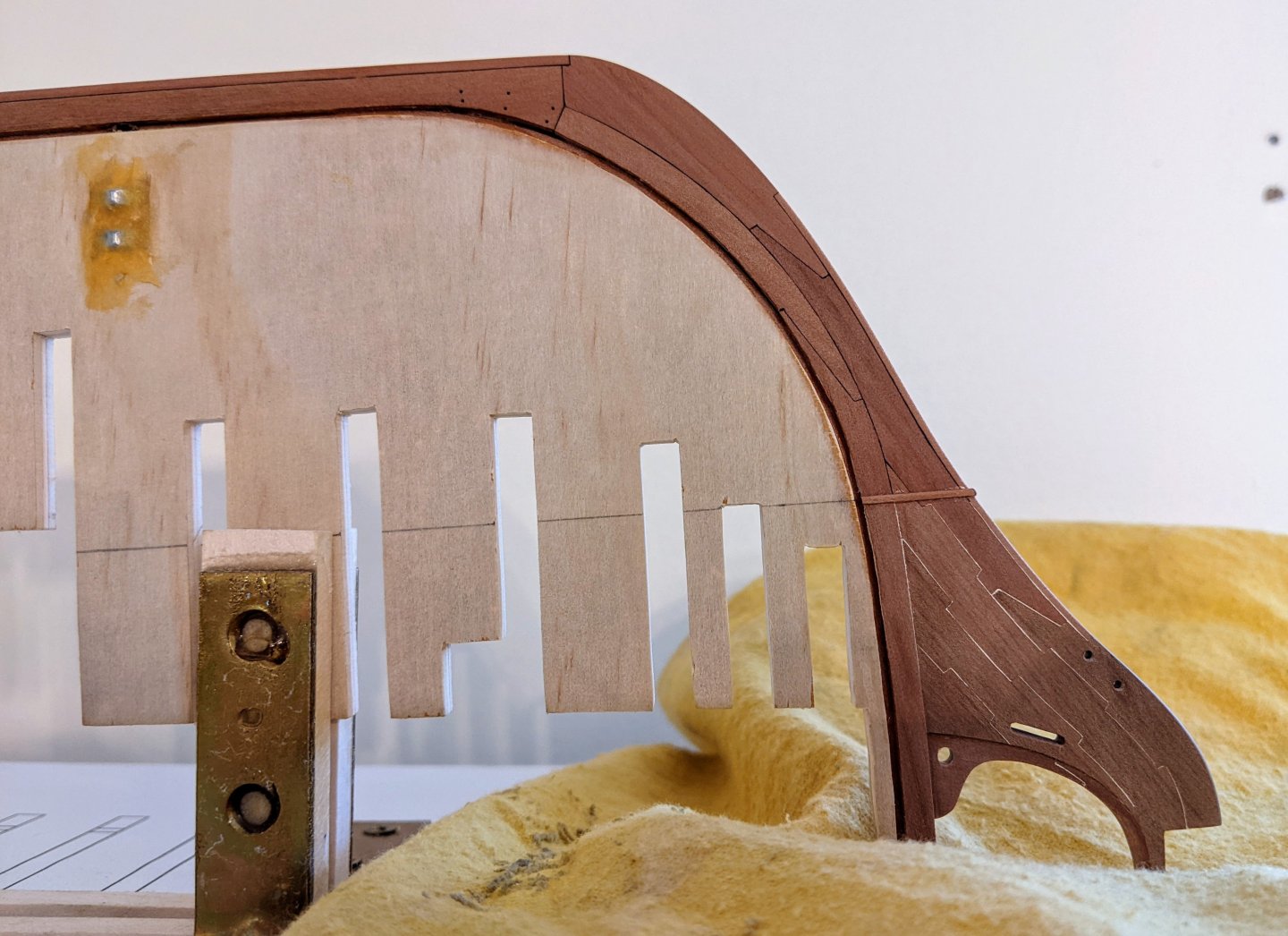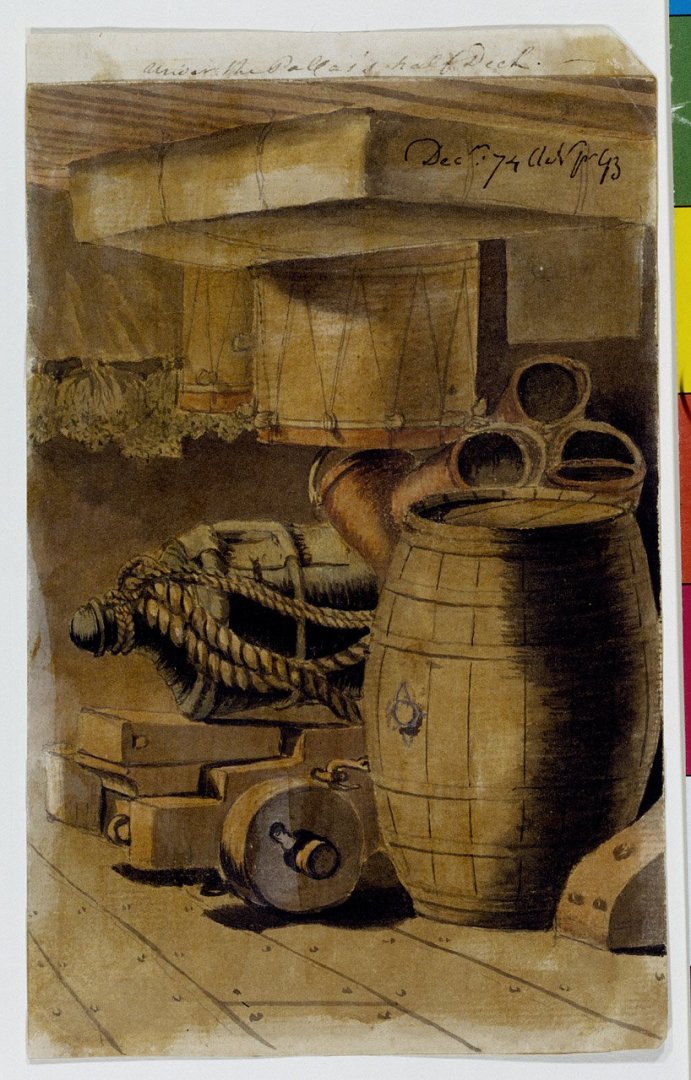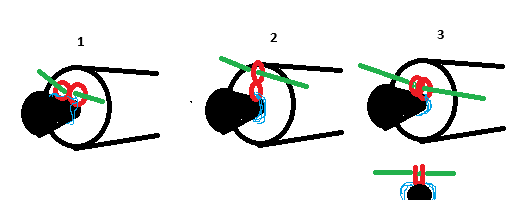-
Posts
1,345 -
Joined
-
Last visited
Content Type
Profiles
Forums
Gallery
Events
Everything posted by Thukydides
-
Congrats on a great build. You have taken the kit and made it your own. I appreciate all the little details you have added.
- 38 replies
-
- Alert
- Vanguard Models
-
(and 1 more)
Tagged with:
-
Thanks Jacques, Oh it was expensive, in many cases it cost almost as much as it cost to build the ship in the first place. For example Perseus was built by contract for a cost of £4,507, but her coppering cost £4,310. That said there were certainly some significant benefits. Many of the refits that you see documented often cost 50% of the ships original cost to complete. One document I have just finished transcribing is an analysis of the impact of coppering and he has this to say:
-
Log #24: Structural Supports & Fixing Mistakes Thanks to everyone who has stopped by to take a look at the log. I do find your comments and likes motivate me to keep pushing forward. Since my last log entry I have continued to work on the structure of the model. I will discuss that in more detail below, but I have also in the background been continuing my work on research. My current focus is on the coppering of Perseus. She was one of the first ships in the RN to be coppered and though I am not planning on coppering her, I am planning some aesthetic choices which will allude to the coppering. The handwriting of the documents I am currently looking at is not as good as some of the stuff I have previously looked at so it is slow going with the transcriptions at the moment. But I thought I would share an interesting tidbit I found. It is interesting to see how quickly the RN went from very few ships coppered to coppering a huge share of the fleet. You can see in the above transcription that from 1779 to 1781, 313 vessels were coppered. On the model itself, I have now got all the bulkheads in place. You will notice that the front two and stern two bulkheads do not have any bracing pieces as they are closer together. The reason for the omission is that I am planning on filling in these sections fully with filler blocks. First I cut the bow filler pieces and glued them in place. Then once that was dry I slid pieces of basswood which I had thinned to the appropriate thickness into the gaps between the bulkheads and marked off with pencil the approximate size they needed to be before cutting them out on the scroll saw. There is no need to be particularly accurate here so I have erred on making them oversized as this will all be sanded in the faring process. The most important part of this was making sure the bulkheads remained square through this process. However, it was around this point that I realized I had made a mistake with one of the bulkheads. Essentially the slot was not deep enough and so it was not far down enough on the center bulkhead. It was only off by about a mm, but this is enough to throw off the lines of the ship. So I had to break out the isopropyl and slowly work it free with a knives and solvent. It was particularly unfortunate that the offending bulkhead was at just about the worst possible location (the stern platform also had to be removed). However after a few hours of working slowly and carefully on it, I managed to get it out. Then I sanded and dry fitted it back in place, making extra sure of the positioning this time :). Finally, I have also been starting the outer structural supports. This is a line of bracing pieces which run along the upper deck line. These serve three purposes: To allow me to correct for any warped bulkheads which might be square at the base, but are not square at the upper deck bulwarks. To strengthen the overall structure. To allow me to better see the line of the main deck to determine if I need to make any adjustments. These pieces are inserted square to the bulkheads, but at an angle such that they follow the sheer of the deck. I will then use a combination of planes and sanding to trim them back in line with the frames. Getting the sheer of the main deck right is crucial as it will determine the height of the gun ports. It feels like this structural work is taking a really long time, but I am trying to avoid future problems by making sure I am constantly checking to make sure everything looks good now while it is easier to fix.
-
Great job Chris. The buoys are well done.
- 38 replies
-
- Alert
- Vanguard Models
-
(and 1 more)
Tagged with:
-
I think that looks much better than your previous versions. Great jobQ If you would like some suggestions to make it really pop, I would still go up a little higher in value on the highest highlights of the red. Maybe mix a bit of orange in with your red to get that highest highlight. On the gold I would use pure white or maybe white with a little yellow in it and try and pick out the upper edges of the monogram and any sharp upper edge points such as the tips of the cannons. This would be really small dots/lines, but it will push that contrast just that bit higher.
- 111 replies
-
- Christiania
- Vanguard Models
-
(and 1 more)
Tagged with:
-
I agree with the others that the second is probably the better option. What I would suggest is there is a bit too much of a hard transition from the bonsai to the rock. To alleviate this you could add some moss around the base of the bonsai to allow for a transition to the rock. Not much, just a little to make it less of a hard line between the two.
- 106 replies
-
- Kentoshi-Sen
- bottle
-
(and 1 more)
Tagged with:
-
Great job on the anchor. It does look like rusty metal.
- 312 replies
-
- Chile
- Latin America
-
(and 6 more)
Tagged with:
-
I don't have a tonne of progress to show, but as it has been about a week since I last posted I figured I would give a short update. I continue to work away at the bulkheads and am now nearing the end. The only bulkheads left to put in place are the final two at either end. I have left these till last as the stern ones are the most fragile and the bow ones need some pre-fairing before I glue them in place. Still lots of structural work to go, but she is starting to take shape now.
-
This is what you want to do. If you have to force the planks into place they are not shaped right. The best advice I can give you it to treat every single plank as its own project. The planking is one of the more consequential parts of the model in terms of determining its look. So it pays to take your time with it.
-
Great job, both the research and the execution.
- 233 replies
-
- Model Shipways
- constitution
-
(and 5 more)
Tagged with:
-
Time for a minor update. I continue to add bulkheads and am getting close to the bow at this point. You may notice some of the bulkheads have been painted black. The reason for this is I am as of yet unsure how much of the main deck I will open up to being visible and so on the off chance that these parts are seen I want them to fade into the blackness of the lower deck. They represent areas that would actually have been open and so we need to create the illusion of space. One thing I don’t think I appreciated fully until now is how much minor errors or slight alignment issues can have significant impacts on a model when it comes to the main structure. I ran into one issue (though I was able to correct it) and since have been much more careful about checking everything in all 3 dimensions. This all makes me very thankful that the Vanguard Models kit I used for my first model was so precise. Really I took the structure of the model for granted. It is much harder when you have to cut and align everything yourself and even parts being a millimetre off can make a significant difference. Thanks to everyone who is following along for all your encouragement.
-
Great job. I like the top one the best. It just needs a bit more, it feels like it has the most depth. The issue is the mid tones need to be brighter so you need to extend what you have for highlights down over more of the surface and go for even higher values on the highlights. In general it is better to make too much contrast as opposed to too little. You can smooth it all together with a thin glaze of your mid-tone once you are done if you think you went too bright. If you do this be careful that you don't let it pool in the recesses. It will have the consistency of a wash, but you don't want to use it like one. Glazing over the transitions using the darker colour pulling from light to dark will also help with smoothing out the transitions if you are concerned about them.
- 111 replies
-
- Christiania
- Vanguard Models
-
(and 1 more)
Tagged with:
-
Good luck, you seem to have made a good start.
- 9 replies
-
- Vanguard Models
- Sherbourne
-
(and 1 more)
Tagged with:
-
I used a combination of matt acrylic varnish and CA glue (not together). If your rope is natural fibre then diluted white glue will work well. However if using polyester rope I found that white glue just did not hold. I used CA when I needed it to be strong and varnish when I needed it to just help a bit. You have to be really careful with the CA as you want to use only the tiniest amounts. As much as possible use non glue methods to secure things (the actual knotts that were used, running thread through other ropes to secure it etc…). I discussed some of the specific solutions I used in my Alert log. Just note I was learning as I went along so I would recommend my later techniques over my earlier ones.
-
Welcome, a cutter is a great choice for a first wooden model. Good luck.
-
The ship is looking so good Glenn. Though I think what I find most interesting about these builds is the creative ways you go about splitting them into sub assemblies to fit them into the bottle. Looking forward to seeing her in the bottle.
- 106 replies
-
- Kentoshi-Sen
- bottle
-
(and 1 more)
Tagged with:
-
As Alan said it is wipe on poly, a thin polyurethane that you wipe on with a rag and then immediately wipe off. You can build it up in several layers to get a very nice finish. I only used two layers at this point since it will be applied over the whole hull again at some point, but I need to paint / plank before I start adding more. It makes the wood slightly darker for every layer you add and so I want the keel to be slightly darker than the planking (to help differentiate it), but not too much so. If you search you can find a number of guides to using WOP here on MSW. I didn't discuss this in detail in the post, but the reason the upper part of the stem looks much duller is I pretty much sanded away the layer of WOP I added to it initially. I want the ink I am going to use to paint it to sink into the wood and so I don't want the WOP barrier in the way.
-
Log #23: The First Bulkheads The final step before starting work on the bulkheads was I needed to mark the waterline. As previously mentioned I realized that the waterline on the Perseus is not actually parallel with the keel and so I wanted to mark the two ends of it while I could still lay the center bulkhead flat on a template. Asthetically I am not planning on coppering Perseus, but I want to give a nod to the fact that she was coppered so I am planning on adding a batton along the waterline to mark it as if the coppering was there. This batton is prevalent on a number of coppered models, most notably the bellona model. However there is limited documentation on how big to make this so I went with a combination of what seemed reasonable, how big the batton in the bellona model looked and what looked nice on the model. In the end I used a 3/64 x 1/64 batton equating to a 1 inch by 3 inch strip at scale. I also added a second coat of WOP below the waterline as this area won’t be painted and some extra protection couldn’t hurt. Once the WOP was dried and sanded I covered up the keel and head with masking tape to protect it and secured the whole assembly to the build board with the brackets and screws. Then I started adding the first of the bulkheads. I started by adding in the first two using lego to hold everything square. The lego was clamped to the center bulkhead and then the individual bulkheads clamped on both sides to the lego blocks. Lego is a convenient tool for this as it is readily available in my house and can be adjusted to a wide variety of shapes and sizes. Then I worked backwards until I hit the last of the shorter bulkhead pieces. From this point on I worked forwards as I want to add the taller more fragile bulkhead pieces last to minimize the risk of.me accidentally breaking them. As I approach the cut outs for the ladders from the lower deck down to the hold I needed to modify the lego shapes to make sure there was enough surface contact with the center bulkhead, but also to leave gaps to go around the nuts that screws securing the model to the base go into. The process is not quick as I need to glue and clamp the bulkhead in place and then shape the spacer pieces such that they can slide into the gap smoothly. I then need to leave the whole thing clamped until it is dry (3-4 hours to be on the safe side). I am also being very careful as I want to make sure everything is square and good. Mistakes at this point could be a big problem later on if I don’t line everything up right. This is a very encouraging part of the build as after a lot of prep work the shape of the ship is starting to take shape.
-
Welcome to MSW, what kit are you going to be building?
-
The double thimble vs just a single one, is not something I have seen anyone give a plausible explanation for, maybe because they are stronger? The thing is even if I think 3 is most likely, it is very plausible that the orientation could be reversed (thimble below the pomillion), or alternatively the breaching was wrapped around the pomillion and then passed through the thimbles. I have done a lot of looking through the background of maritime paintings and the problem is there are very few depictions of detailed deck scenes prior to the Napoleonic era so almost all the examples I have found are of Bloomfields with the ring as part of the cannon. The only two good examples from earlier periods that I have found appear to show a c**t splice as the means of securing the gun, though they also seem to have the tackles wrapped around the pomillion too. https://www.rmg.co.uk/collections/objects/rmgc-object-200784 https://www.rmg.co.uk/collections/objects/rmgc-object-200785
-
The only issue with that interpretation is the thimble is strapped to the pommillion. My guess is one of the options below (I feel the third is the most likely, but I have no evidence for this). Not obviously not to scale, just to give you the idea. Red is the thimble, green the breaching and blue the strap. I have included an alternate view of 3 below it looking straight on to clarify it. 1) Figure 8 shape lying flat against the breach strapped to the pomillion. The breaching is reaved through both loops. 2) Figure 8 shape with the bottom loop strapped to the pomillion and the breaching reaved through the upper loop. 3) A bent over figure 8 such that the thimbles are next to each other. A strap is run through both to strap it them to the pomillion. The breaching is reaved through them both. The reason this seems the most likely to me is that it sort of resembles the later loops that were cast on to the guns which makes that progression seem natural.
About us
Modelshipworld - Advancing Ship Modeling through Research
SSL Secured
Your security is important for us so this Website is SSL-Secured
NRG Mailing Address
Nautical Research Guild
237 South Lincoln Street
Westmont IL, 60559-1917
Model Ship World ® and the MSW logo are Registered Trademarks, and belong to the Nautical Research Guild (United States Patent and Trademark Office: No. 6,929,264 & No. 6,929,274, registered Dec. 20, 2022)
Helpful Links
About the NRG
If you enjoy building ship models that are historically accurate as well as beautiful, then The Nautical Research Guild (NRG) is just right for you.
The Guild is a non-profit educational organization whose mission is to “Advance Ship Modeling Through Research”. We provide support to our members in their efforts to raise the quality of their model ships.
The Nautical Research Guild has published our world-renowned quarterly magazine, The Nautical Research Journal, since 1955. The pages of the Journal are full of articles by accomplished ship modelers who show you how they create those exquisite details on their models, and by maritime historians who show you the correct details to build. The Journal is available in both print and digital editions. Go to the NRG web site (www.thenrg.org) to download a complimentary digital copy of the Journal. The NRG also publishes plan sets, books and compilations of back issues of the Journal and the former Ships in Scale and Model Ship Builder magazines.

